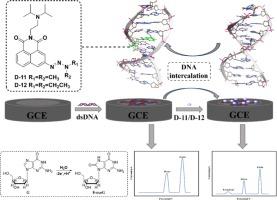Bioorganic Chemistry ( IF 4.5 ) Pub Date : 2024-01-18 , DOI: 10.1016/j.bioorg.2024.107141 Ping Sun 1 , Na Xu 2 , Xue Zhang 1 , Yun-Fei Gao 1 , Jia-Yin Zhang 1 , Qi-Ming Zhang 1 , Chen Liang 1 , Ri-Lei Yu 3 , Ya-Mu Xia 1 , Wei-Wei Gao 1

|
In this work, we rationally designed and synthesized two novel triazene-amonafide derivatives 2-(2-(diisopropylamino)ethyl)-5-(3,3-dimethyltriaz-1-en-1-yl)-1H-benzo[de]isoquinoline-1,3(2H)-dione (D-11) and 5-(3,3-diethyltriaz-1-en-1-yl)-2-(2-(diisopropylamino)ethyl)-1H-benzo[de]isoquinoline-1,3(2H)-dione (D-12) as potential antitumor agents. The DNA damage induced by the intercalation mode of D-11 (D-12) towards DNA was electrochemically detected through the construction of efficient biosensors. The consecutive processes of reversible redox of naphthylimide ring and irreversible oxidation of triazene moiety were elucidated on the surface of glassy carbon electrode (GCE) by CV, SWV, and DPV methods. Electrochemical biosensors were obtained through the immobilization of ctDNA, G-quadruplexes, poly(dG), and poly(dA), respectively, on the clean surface of GCE. After the incubation of biosensors with D-11 or D-12, the peaks of dGuo and dAdo decreased prominently, and the peak of 8-oxoGua appeared at +0.50 V, suggesting that the interaction between D-11 (D-12) and DNA could result in the oxidative damage of guanine. Unexpected, the as-prepared DNA biosensor possessed satisfactory anti-interference property and good practicability in real samples. UV–vis and fluorescence spectra, and gel electrophoresis assays were employed to further confirm the intercalation mode of D-11 (D-12) towards DNA base pairs. Moreover, D-11 was proved to exhibit stronger anti-proliferation activity than mitionafide and amonafide against both A549 and HeLa cell lines.
中文翻译:

合理设计和合成三氮烯-amonafide衍生物作为新型潜在抗肿瘤剂,通过嵌入模式对DNA造成氧化损伤
在这项工作中,我们合理设计并合成了两种新型三氮烯-amonafide衍生物2-(2-(二异丙氨基)乙基)-5-(3,3-二甲基三嗪-1-en-1-yl)-1H-苯并[ de ]异喹啉-1,3(2H)-二酮 ( D-11 ) 和 5-(3,3-二乙基三嗪-1-en-1-基)-2-(2-(二异丙氨基)乙基)-1H-苯并[ de ]isoquinoline-1,3(2H)-dione ( D-12 ) 作为潜在的抗肿瘤剂。通过构建高效生物传感器,电化学检测D-11 ( D-12 ) 对 DNA 的嵌入模式引起的 DNA 损伤。通过CV、SWV和DPV方法阐明了玻碳电极(GCE)表面上萘酰亚胺环的可逆氧化还原和三氮烯部分的不可逆氧化的连续过程。通过将ct DNA、G-四链体、聚(dG)和聚(dA)分别固定在 GCE 的清洁表面上获得电化学生物传感器。生物传感器与D-11或D-12孵育后,dGuo和dAdo的峰明显下降,8-oxoGua的峰出现在+0.50 V,表明D-11 ( D-12)和D-11(D-12 )之间的相互作用DNA可能导致鸟嘌呤的氧化损伤。出乎意料的是,所制备的DNA生物传感器在实际样品中具有良好的抗干扰性能和良好的实用性。采用紫外可见光谱和荧光光谱以及凝胶电泳测定进一步确认D-11 ( D-12 ) 对 DNA 碱基对的嵌入模式。 此外, D-11被证明对 A549 和 HeLa 细胞系表现出比 mitionafide 和 amonafide 更强的抗增殖活性。















































 京公网安备 11010802027423号
京公网安备 11010802027423号